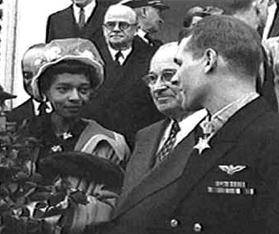
Of course, you know who is today's FbF. Who else? It is EagleOne and my guest on Midrats this Sunday at 5pm EST - CAPT Thomas J. Hudner Jr., USN (Ret). I'm going to steal this from my bud Stephen at AcePilots ... but I don't think he will mind.
Flying one thousand feet above the icy Korean mountains, the Corsair's engine cut out. At such a low altitude, the pilot, US Navy Ensign Jesse Brown, couldn't bail out or clear the mountain. He spotted an opening that looked more or less flat, and in any case, it was his only choice. A wheels up, dead stick landing. The Navy's first African American aviator probably thought that he had been through worse than this, being hazed and harassed throughout his pioneering Naval career.
The F4U went down heavily and smashed into the rough terrain, folding up at the cockpit. Sliding through the deep snow, the big fighter started smoking immediately.
Lt. (Jg) Thomas Hudner and the other VF-32 pilots studied the situation on the ground as they circled overhead. This close to the Chosin Reservoir, Chinese Communist soldiers would be along soon. The crashed and burning aircraft was a hopeless wreck. At first the Navy fliers thought that Ensign Brown was dead. Then his wingman and roommate, Lt. William H. Koenig, noticed Brown waving to them through the open canopy of his Corsair (Bureau # 97231). A rugged, prop-driven, big-nosed WWII design, the Chance Vought F4U normally could take a lot of damage. On this day, 4 December 1950, Brown had been tragically unlucky; some North Korean flak gunner had hit the plane in a vulnerable spot.
Flight Leader Richard L. Cevoli radioed "Mayday" and called for helicopter rescue. A Sikorsky HO3S helicopter was dispatched, but would take at least 15 minutes to reach the stricken flier. Lt. Hudner looked down at his friend and flying mate. He promptly decided to go down and try to pull Brown out the smoldering aircraft. Hopefully, both pilots could then escape on the chopper.
Hudner made one more tree-top pass and dumped his remaining fuel and ordnance. He dropped flaps and tailhook, and thumped the Corsair onto the ground. He hit a lot harder than he had expected. At 6,000 feet above sea level, the Corsairs' air speed indicator had understated the actual speed. Hudner began to wonder if this had been such a good idea.
"I knew what I had to do," said Hudner in an interview by Frank Geary, for Jax Air News, the Naval Air Station Jacksonville, Fla., base newspaper. "I was not going to leave him down there for the Chinese. Besides, it was 30 degrees below zero on that slope, and he was a fellow aviator. My association with the Marines had rubbed off on me. They don't leave wounded Marines behind."
Hudner tightened his harness and, with his wheels up, set his Corsair down onto the snow and rocks some 100 yards from Brown's smoking aircraft. "He was alive, but barely, when I got onto his wing and tried to lift him out of the cockpit. But his right leg was crushed and entangled in metal and instruments. I hurried back and requested a rescue helo, making sure it would bring an ax and a fire extinguisher. When I got back to Brown, I began packing snow around the smoking cowling.
"When a two-man Marine helicopter arrived with only its pilot, the ax he carried proved useless in our efforts to hack away the metal entrapping Brown's leg. He was going in and out of consciousness and losing blood. "The helo pilot and I, in our emotion and panic, and with the light of day fading, discussed using a knife to cut off Jesse's entrapped leg. Neither of us really could have done it, and it was obvious Jesse was dying. He was beyond help at that point. The helo pilot said we had to leave. Darkness was setting in and we'd never get out after dark," said Hudner. "We had no choice but to leave him. I was devastated emotionally. In those seconds of our indecision, Jesse died."'Nuff said. More over at AcePilots.
First posted May 2010.









No comments:
Post a Comment